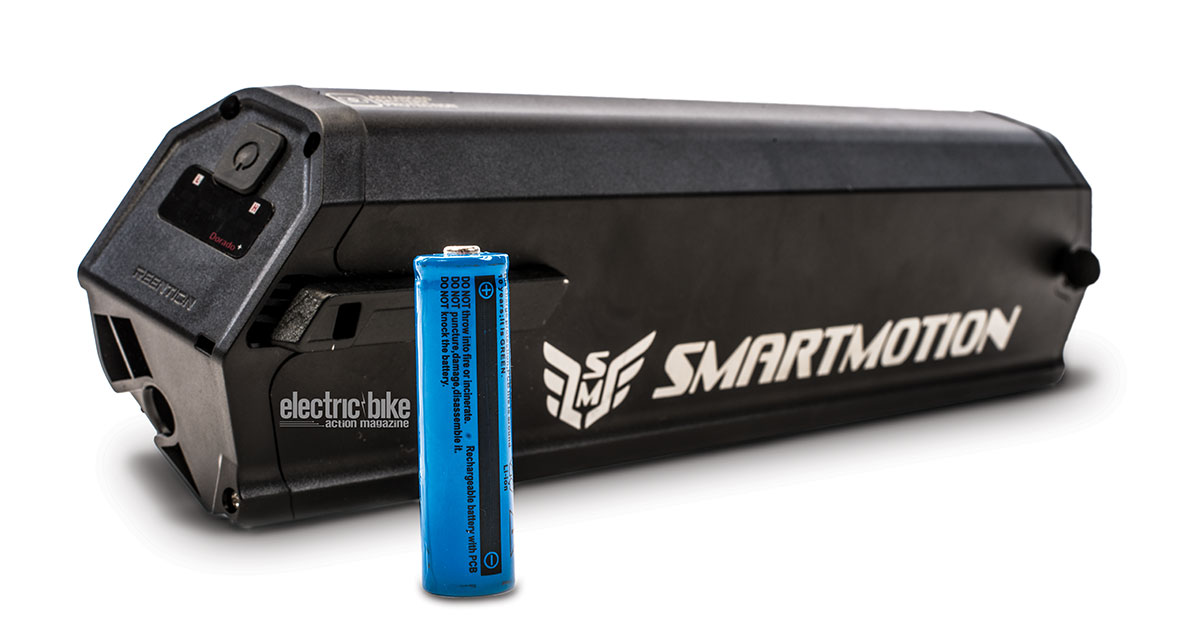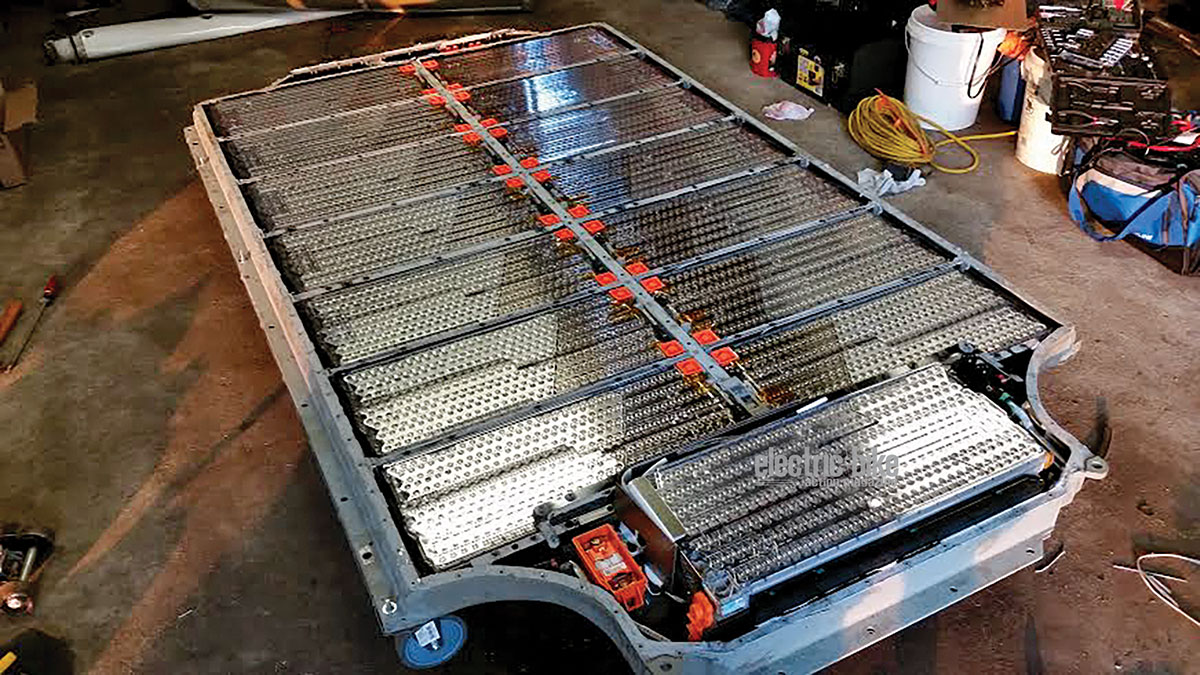WHAT’S CURRENT WITH YOUR BATTERY
Sean


We’ve been using lithium-ion batteries for over a dozen years now. Physicist John Goodenough is credited with the identification and development of the Li-ion battery, and it powers much of what we use today—from laptop computers to power tools to Tesla vehicles to most electric bikes. Interestingly, most all of these devices use the same cells, called an 18650 Li-ion battery, so named because it is 18mm x 65mm in size.
The automaker Tesla uses about 7000 of them to power a Model S. By using so many batteries, they can have a significant amount of storage capacity, which is why they have great range and power and why the upper-end models can accelerate to 60 mph faster than a Ferrari.
AVOID THE FIRE
When Lee Iacocca’s eBike bikes first switched from lead-acid to Li-ion in the early 2000s, the technology wasn’t ready for prime time. The batteries could catch fire, and a few people burned their garages to the ground when charging their bikes. Li-ion is also very sensitive to damage, and some early Tesla vehicles ran over metal pieces on the road and punctured the battery, which is built into the floor pan of the car for better weight distribution, and set the car on fire. Tesla has since created some great technology to avoid that problem, as well as isolating cells in a way that makes them not ignite each other. A lithium fire can’t be put out; you can’t choke it out by depriving it of oxygen, as the chemical reaction makes its own. You just have to let it burn.
Fire isn’t the only concern with Li-ion batteries. We are also getting close to the maximum capacity of energy we can put into the cells, the energy density, as well as how fast we can charge them and their life expectancy (number of charge cycles before they degrade to the point of being useless. Imagine an e-bike battery that will only provide power for five miles when it used to give you full power for 15–20 miles). In a Li-ion battery, you can expect this to last 500–2000 full cycles on a battery, depending on quality.

THE NEW TECH
There are a number of promising new technologies that are coming down the pike, but that’s still not yet available. Stanford engineers have come up with an aluminum-ion battery. It’s non-flammable, malleable, lightweight and can be charged very rapidly. It showed great promise when announced two years ago, but the problem is that it is about half as energy dense as Li-ion. You’d need a battery close to twice as big to get the same range.
Goodenough has recently come up with a glass electrolyte, the medium between the anode and cathode in a battery, that can be used with lithium or a sodium-ion battery, that allows it to be charged faster and have more energy density. The great thing about the glass electrolyte is that it prevents dendrites, small stalactites of metal, from forming and stretching across the electrolyte, which can lead to short-circuits and possibly fire. That was what was happening to the Samsung Galaxy Note 7 and the many hoverboards that caught fire on Christmas mornings. If this technology can be implemented in the manufacture of Li-ion cells, it will make them safer.
FASTER AND SAFER
We talked to Stephen Voller, founder of the British company called Zap&Go, who is working on a carbon-ion battery. He says their technology is safer than Li-ion, and their charge technology is what makes it even better. They’ve developed a system that is capable of recharging in seconds. They have a drill battery powered by these batteries that can be fully recharged in 10 seconds—10 seconds!
Their system looks very promising, and they are bringing an electric kids’ scooter to market in 2018 that can be recharged in under five minutes and run for at least 15 minutes. That’s their first consumer product, with an electric bicycle battery system planned for 2018 as well. They hope to have it capable of being replacement batteries for OE versions.
This technology is interesting for some, as it would allow a person to quick-charge their battery, even if it doesn’t have quite the same range yet. It’s great if you do a lot of shorter runs and if you’re like many people who forget to charge their battery beforehand. Carbon-ion batteries also have no components that can start a fire or explode, and as such, they’re completely safe for air travel.
Carbon-ion, because of its ability to fast-charge, works much better on regenerative systems. Having regenerative capability on an electric bike, as in the case of many direct-drive motors like on BionX or Stromer, is nice, but with a Li-ion battery, you can’t get the charge into the battery fast enough, so it is virtually useless for anything but creating motor drag going downhill. Carbon-ion could actually make much better use of regeneration.
Carbon-ion has another huge advantage over Li-ion. Whereas Li-ion has an expected life of 500–2000 charge cycles, carbon-ion is rated at over 100,000 cycles. Li-ion uses a chemical reaction inside the battery to move energy around, each time using up a little of the chemicals inside. Carbon-ion doesn’t use a chemical reaction internally, so there’s no degradation and longer life. The battery will now outlive the vehicle or device it is used in.
Zap&Go is starting out making these batteries for power tools, robot vacuum cleaners and bikes, but they’re setting their sights on the car market as well. The idea of being able to fuel up your vehicle with electrons in minutes is compelling, and no doubt could prove necessary, as many car manufacturers and many countries look to electric vehicles as the necessary future.
Other companies are going after battery-powered vehicles in a big way. Tesla is leading the charge, but Volvo has promised to no longer make internal-combustion engine-powered vehicles in five years, and Bosch has invested millions of dollars into motors and battery technology.
It looks like Li-ion is here to stay for the moment, but we’re very excited to try out carbon-ion too. Stay tuned!
THERE ARE SO MANY WAYS TO GET ELECTRIC BIKE ACTION
In print, from the Apple newsstand, or on your Android device, from Google.
Available from the Apple Newsstand for reading on your iPad, iPhone or iPod Touch.
Subscribe Here
For more subscription information contact (800) 767-0345
Got something on your mind? Let us know at tonyd@hi-torque.com
____________________________________
The post WHAT’S CURRENT WITH YOUR BATTERY appeared first on Electric Bike Action.